Pork Adobo with Oyster Sauce is your classic Filipino adobo made extra special! It's easy to make in an hour yet turns out so tasty! You'll love the melt-in-your-mouth tender pork belly and sweet and savory sauce with steamed rice.
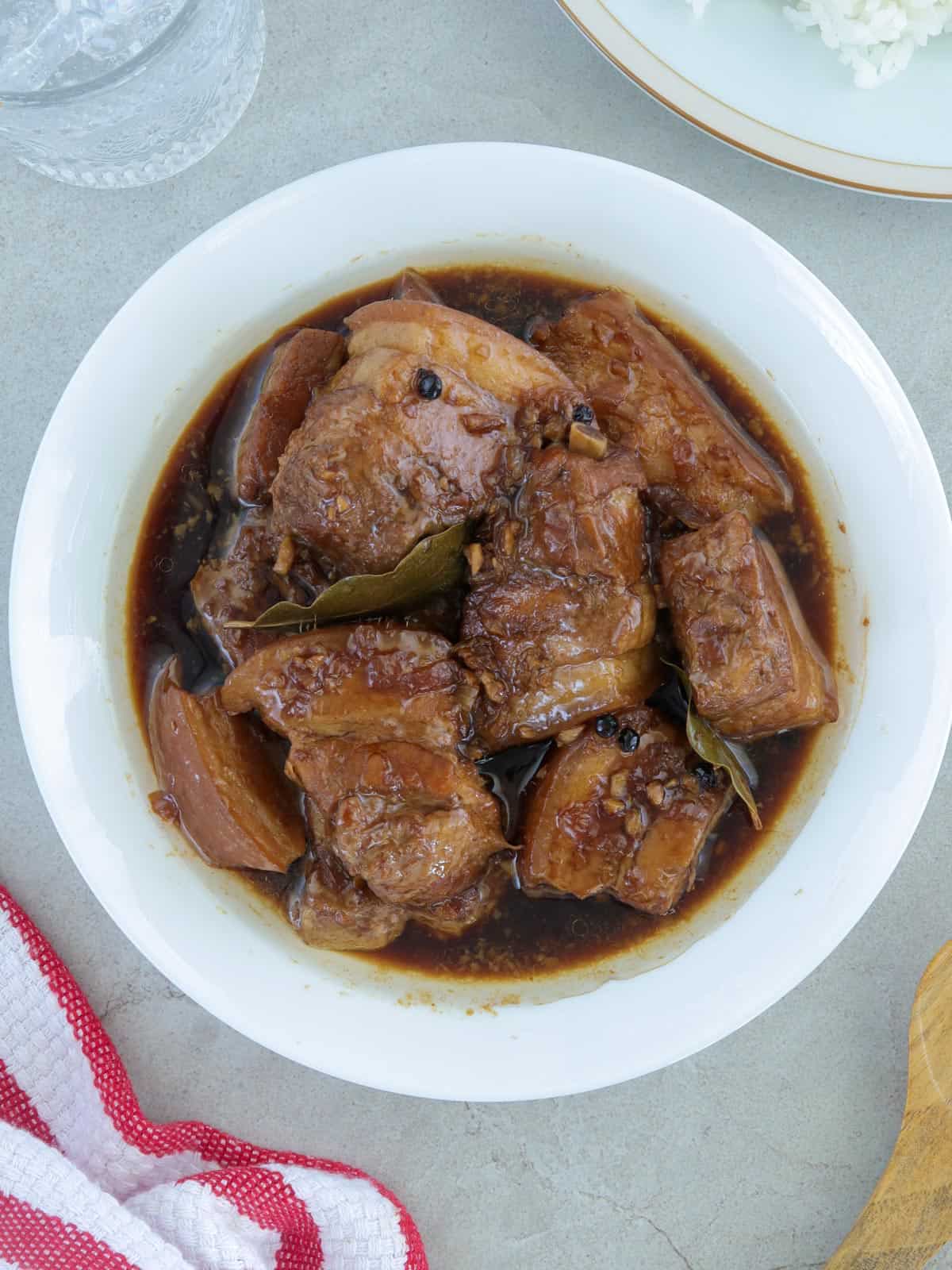
We have 20-plus adobo varieties already on the blog, and I am excited to add another one to the list. You can never have too many adobo recipes, right? Especially when it's made extra yummy with the sweet and savory flavors of oyster sauce!
There are so many ways to prepare this classic Filipino stew, from adobo sa gata and pork ribs adobo with atsuete to adobong dilaw and adobong puti. Every version has its own delicious flavor profile, it's pretty hard to nail down a favorite.
But why pick one when you can make them ALL?
Adobo Ingredients
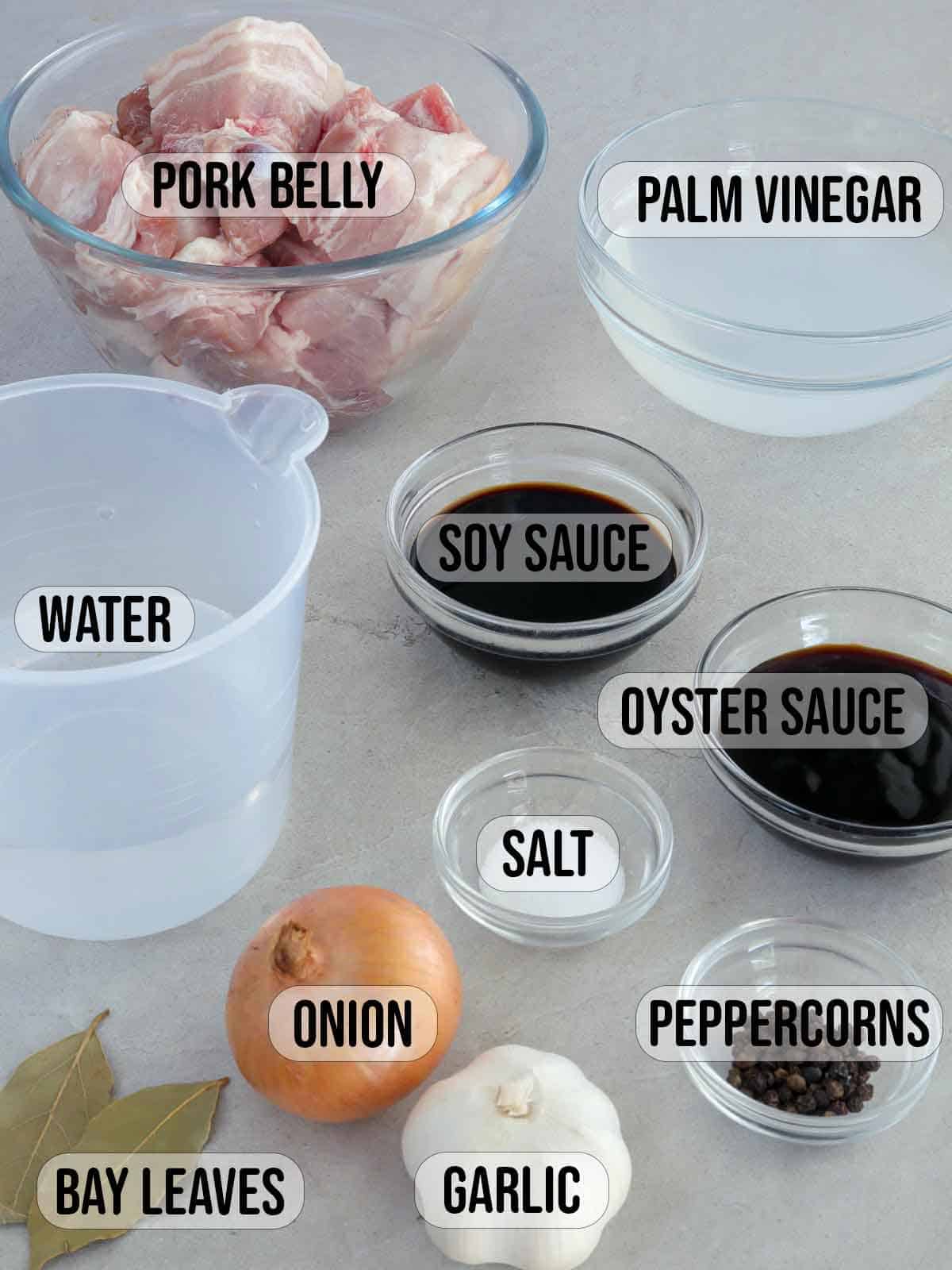
- Pork- I love the deep flavor and velvety texture of pork belly in my adobong baboy, but other cuts such as Boston butt, pork shanks or hocks, pork chops, picnic shoulder, and pork ribs are also great options.
- Seasonings- the Filipino adobo is braised in a mixture of vinegar, soy sauce, and aromatics such as onions, garlic, peppercorns, and bay leaves for a salty and savory taste.
- Oyster sauce- in this pork belly adobo recipe version, a dollop or two of oyster sauce is stirred into the sauce for another layer of flavor.
Pork adobo with oyster sauce cooking process
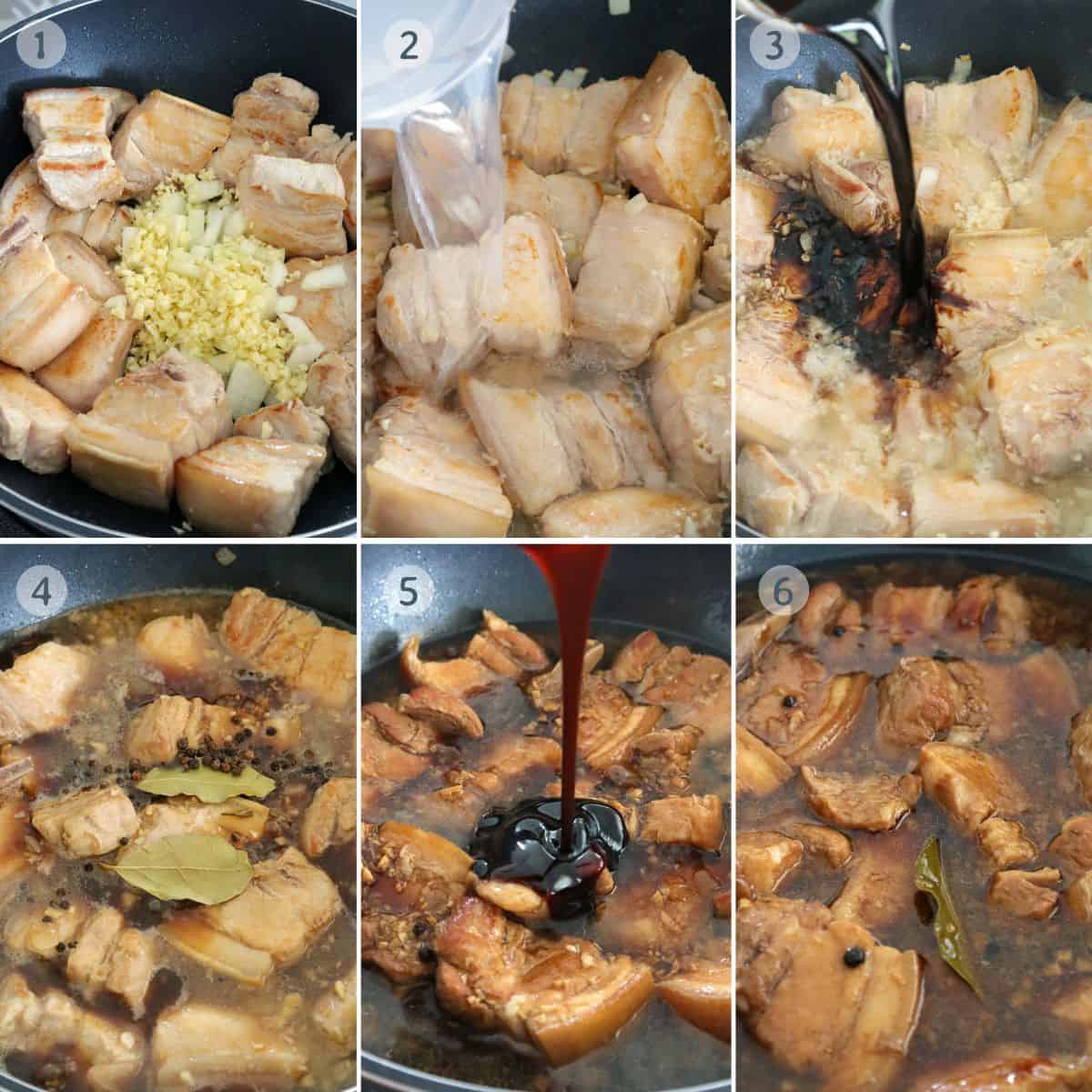
You can marinate the meat before searing if you like, but I find it unnecessary as the low and slow cooking infuses enough flavor.
- Browning the meat adds depth of flavor. Pat the pork dry to ensure a good sear. Do not overcrowd the pan and use a wide pan or cook in batches as necessary. Heat a pan over medium heat. Add pork belly and cook until lightly browned and begins to render fat. Add onions and garlic and cook until softened.
- Add vinegar and bring to a boil, uncovered and without stirring, for about 2 to 3 minutes before adding the soy sauce and water to cook off the strong acid taste.
- Add soy sauce and water. Bring to a boil, skimming any scum that floats on top.
- Add bay leaves and peppercorns. Lower heat, cover, and simmer until pork is fork-tender and liquid is reduced. If the meat is tender before the sauce is fully reduced, remove the lid and increase the heat to allow quicker evaporation. If the sauce is drying out before the meat is sufficiently tender, add more water in ½ cup increments as needed.
- Add oyster sauce and stir to combine. Continue to cook for 1 to 2 minutes.
- As the flavors of the dish will concentrate as the sauce reduces, season with salt and pepper if needed at the end of cook time to accurately gauge taste.
Quick tips
- Cut the meat in uniform size to ensure even cooking. To make slicing easier, freeze the pork belly for about 8 to 10 minutes or until slightly firm.
- The recipe uses palm vinegar (Filipino brand); if you're substituting white distilled, which has a stronger taste, you might need to adjust the amount.
Frequently Asked Questions
Does oyster sauce add flavor?
Yes. Oyster sauce is a condiment made with oyster juice, salt, sugar, and caramel color. It's commonly used in stir-fries, sauces, and marinades to add a sweet, salty, and umami punch.
How much oyster sauce should I use?
I use about ¼ cup in this recipe with about a kilo of pork. The adobo already has soy sauce so make sure to taste text adjust amount as desired lest the sauce gets overly salty.
Is hoisin sauce and oyster sauce the same?
No. Hoisin sauce is has a fermented soy bean base while oyster sauce is made from oyster extract. However, hoisin can make a suitable substitute for the latter especially in vegan or vegetarian recipes. Use 1 to 1 ratio.
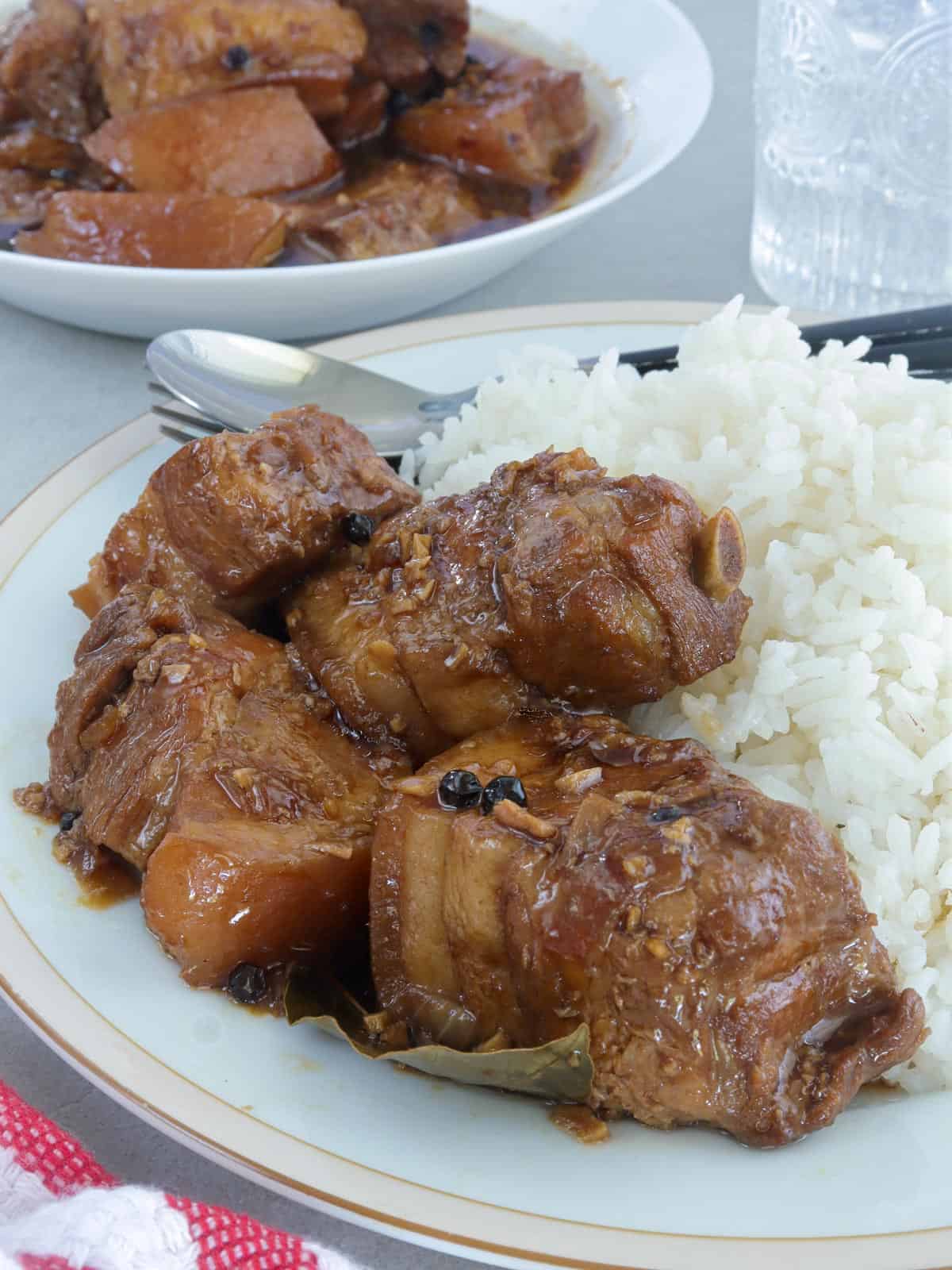
How to Serve and store
- Serve for lunch or dinner with steamed rice and a side of atchara or pickled mangoes to cut through the richness and add a contrast of flavor. Or enjoy for breakfast with sinangag and sunny side up eggs as hearty adosilog.
- Adobo makes great leftovers and will keep in the refrigerator for up to 3 days or in the freezer for up to 3 months. Allow to cool completely and transfer into an airtight container or resealable bag.
- To reheat, place in a saucepan with a splash of water if needed and heat over low heat to an internal temperature of 165 F.
Ingredients
- 2 pounds pork belly, cut into 1 ½-inch cubes
- 1 onion, peeled and chopped
- 6 cloves garlic, peeled and minced
- 1 cup palm vinegar
- ¼ cup soy sauce
- 1 cup water
- 2 bay leaves
- ½ teaspoon peppercorns
- ¼ cup oyster sauce
- salt to taste
Instructions
- In a pan over medium heat, add the pork belly and cook, turning as needed, for about 3 to 5 minutes or until browned and begins to render fat.
- Add onions and garlic and cook until softened.
- Add vinegar and bring to a boil, uncovered and without stirring, for about 2 to 3 minutes.
- Add soy sauce and water. Bring to a boil, skimming any scum that floats on top.
- Add bay leaves and peppercorns.
- Lower heat, cover, and cook until meat is fork-tender and liquid is reduced.
- Add oyster sauce and continue to cook for about 1 to 2 minutes.
- Season with salt if needed. Serve hot.
Notes
- Cut the meat in uniform size to ensure even cooking. To make slicing easier, freeze the pork belly for about 8 to 10 minutes or until slightly firm.
- Browning the meat adds depth of flavor. Pat the pork dry to ensure a good sear. Do not overcrowd the pan and use a wide pan or cook in batches as necessary.
- The recipe uses palm vinegar (Filipino brand); if you're substituting white distilled, which has a stronger taste, you might need to adjust the amount. To cook off the vinegar taste, allow it to boil, uncovered and without stirring, for a good few minutes before adding the soy sauce and water.
- As the flavors of the dish will concentrate as the sauce reduces, season with salt if needed at the end of cook time to accurately gauge taste.
Video

Nutrition Information
“This website provides approximate nutrition information for convenience and as a courtesy only. Nutrition data is gathered primarily from the USDA Food Composition Database, whenever available, or otherwise other online calculators.”

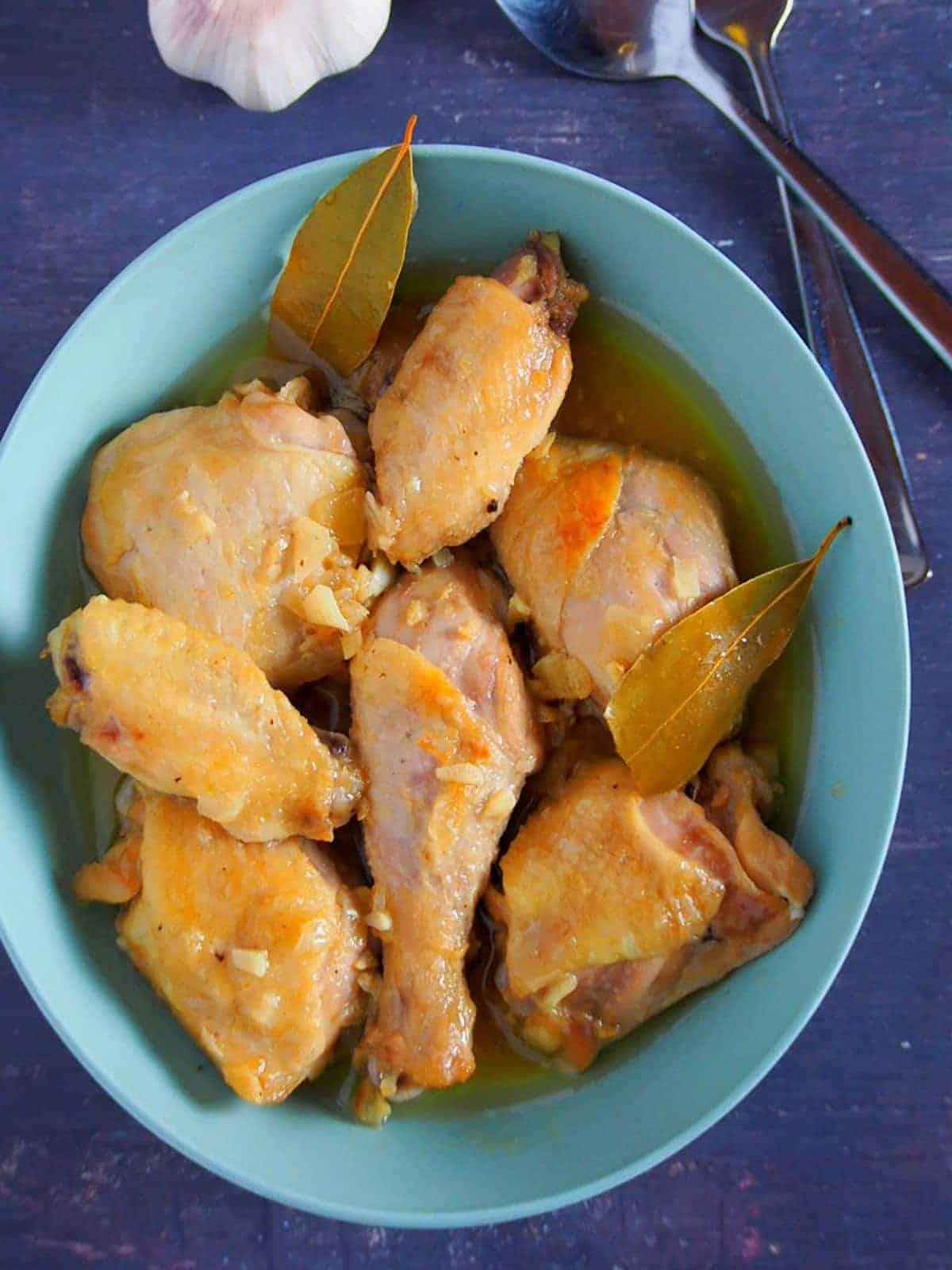
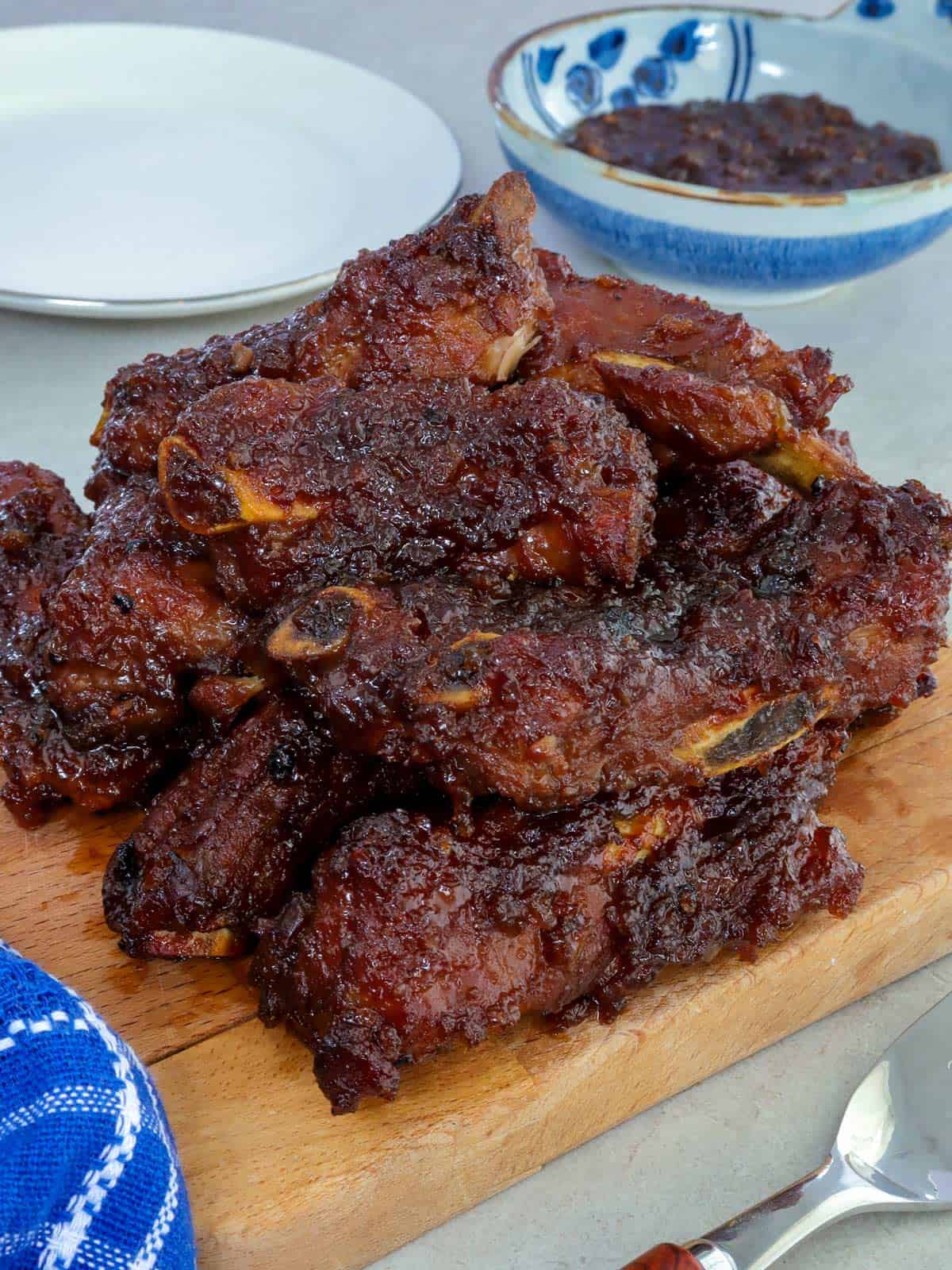
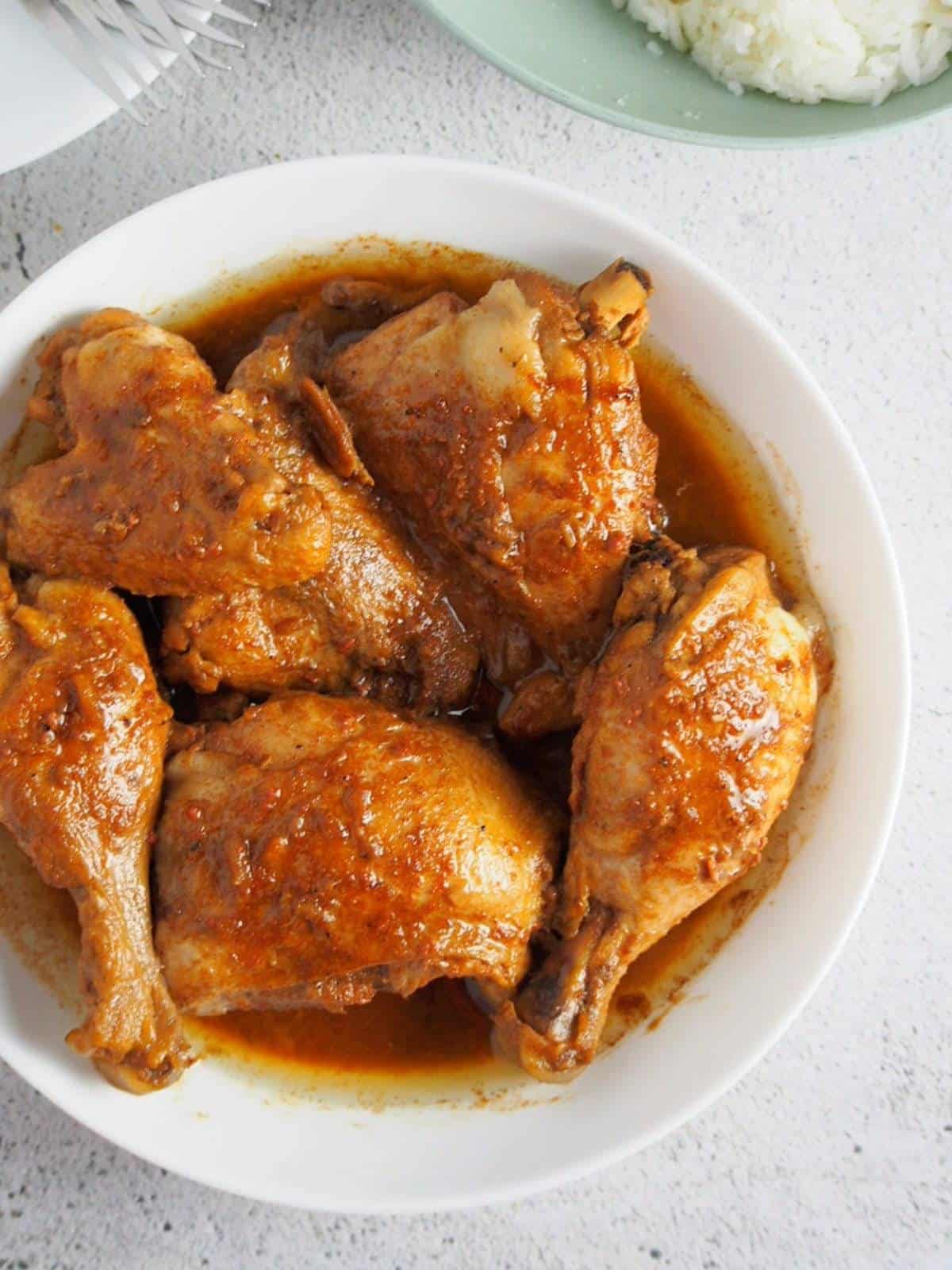
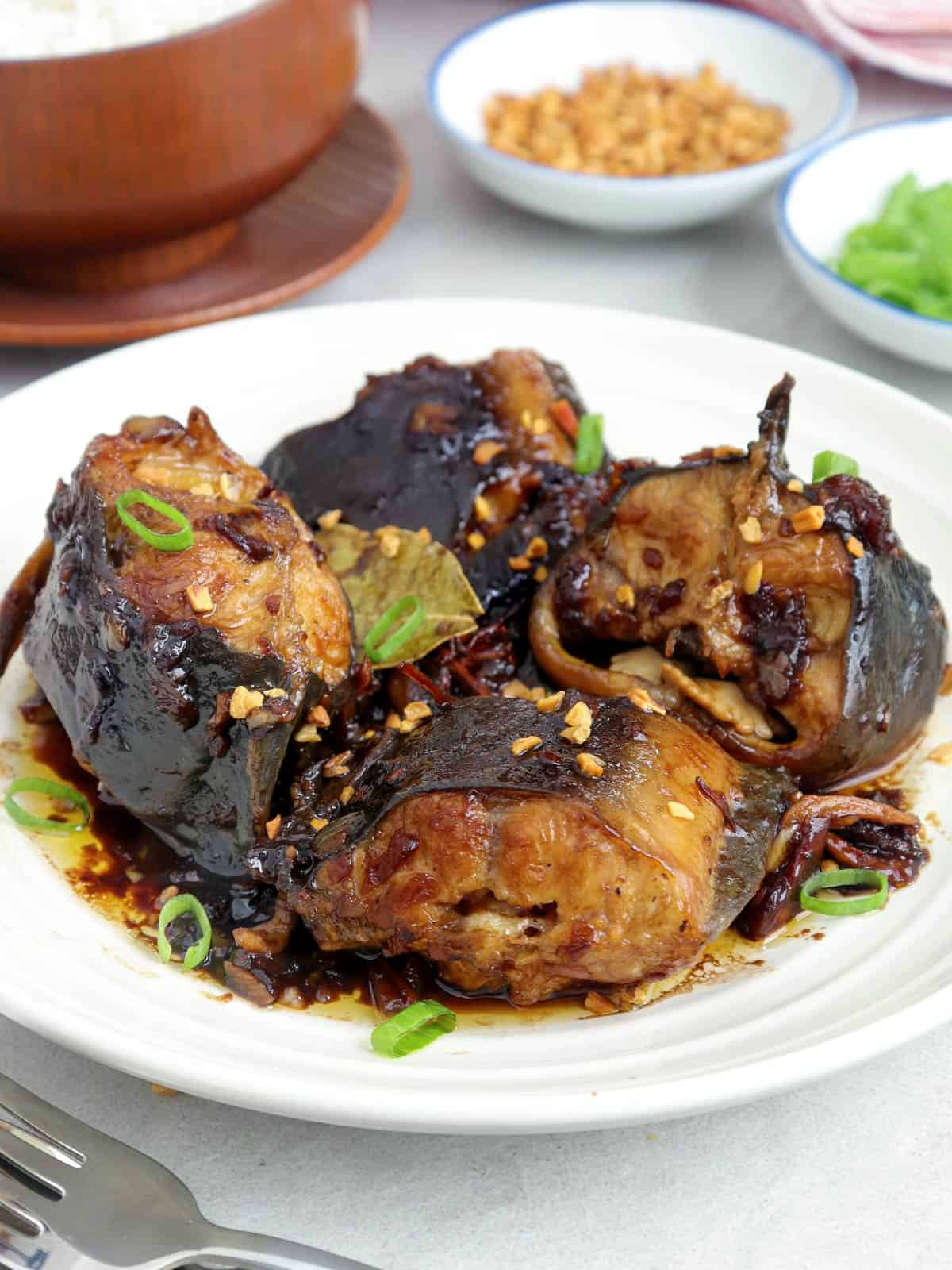
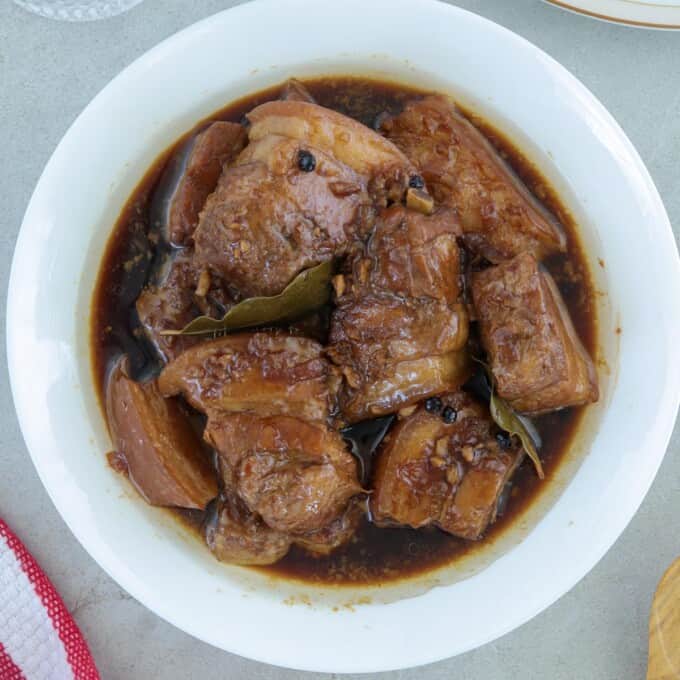

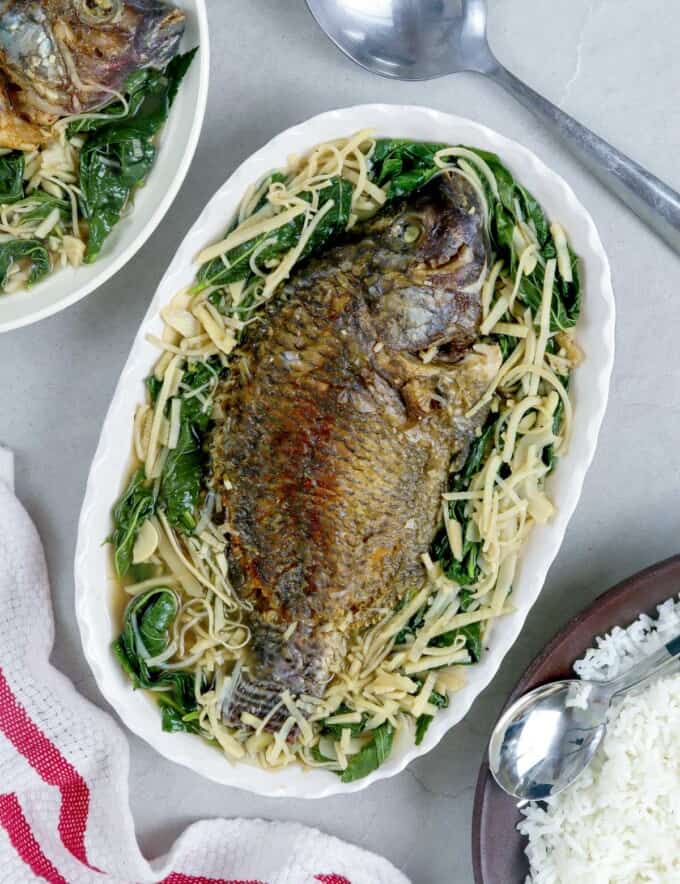
Haidelyn Agustin says
I just tried this recipe for dinner earlier. I used rice vnegar instead since i have no palm vinegar. Wondering why the dish turned so salty?
George Garcia says
Easy peasy and amazing taste...tender cuts of pork and the right amount of sauce.
I just added a token of freshly squeezed of half a lemon...
Lalaine Manalo says
Glad the recipe worked well for you!
Kris H. says
11/14/20
Hi Lalaine,
Kumusta na? I'm a newbie in cooking Filipino food, and I decided to learn and cook more for the family as we stay-at-home during this pandemic. Yesterday, as I was avidly browsing the internet for good Filipino food recipes, I came across your website and found a lot of recipes that resemble the food and recipes Tatay used to cook for us when we were growing up. I'm looking forward to trying out a lot of your recipes this winter esp. the classic sinigang, adobo, lumpia, and the bibingka. Anyway, congratulations on your success in launching this cooking website. I love that your website is well-designed, printer-friendly, and the serving is easily adjustable to reflect preferred portion. I will refer your site to my sisters so they can also learn to cook a
more-authentic Filipino cuisine. Salamat!
- Kris H.
Lalaine Manalo says
Thank you so much, Kris.
Nimpaflores says
I love it kawaling pinoy recipe
Lalaine Manalo says
Thank you!
ailyn gaddi says
i love your recipes. i want to learn to cook healthy food.
Salvador Gonzales... says
I like the Impossible Chocolate Flan Cake I made the cake but I give to the church they like it. I have a recipe I got it Food.Network and good also.thanks
Lalaine Manalo says
You're welcome. I am glad you enjoyed it 🙂
Sheryl says
I added 1 cup of apple cider vinegar bc that’s all I had and it was too strong. I feel like I completely ruined it -___- I’m so sad about it ugh. Way too tangy. Does distilled white work better if no palm vinegar?
Lalaine Manalo says
I use apple cider vinegar when I ran out of palm vinegar. Although it has a sharper tang, I think the overall taste is fine. The trick is to let it boil uncovered and without stirring to cook off the strong acid taste. You can also add a bit of sugar to balance the sourness.
James says
I just made this with your sinangag recipe and... ang sarap naman! The only additions I made were two small tablespoons of brown sugar, four habaneros (I'm half bicolano so... I need heat and sweet in my adobo lol), and I used up my last two bottles of vinegar so it ended up approximately 1/4 cup Datu Puti and 3/4 cup coconut vinegar. Maraming salamat po!
Lalaine Manalo says
I am glad the recipe worked well for you! A little spice sounds good in adobo; will definitely try adding some chili peppers next time. Thanks for the tip!
Malou M says
I’m now trying this recipe using chicken instead of pork belly. I hope it will turn out well, just like when I used pork liempo in your original recipe.
Lalaine Manalo says
Chicken is delicious in any adobo recipe. Happy cooking!
kristine chiong says
seems the taste will turned out to be sour considering 1 cup of vinegar unless you will suggest what kind of vinegar that you have been using. i have tried your recipe chicken adobo which has almost the same ingredients 1 cup of vinegar and followed uncovered it while adding the vinegar,still very sour.
Lalaine Manalo says
Hello, Kristine,
May I ask please if the ingredients were properly measured? One cup which is 8 ounces or 240 ml shouldn't be too much for 2 to 3 pounds of meat. It really is not a lot and when it's allowed to boil for 3 to 5 minutes, that should be enough to cook off the strong acid taste. I use Datu Puti palm vinegar or any Filipino brand. Thanks for the tip, I'm going to update the recipe to note this because I think distilled white vinegar is very strong tasting.